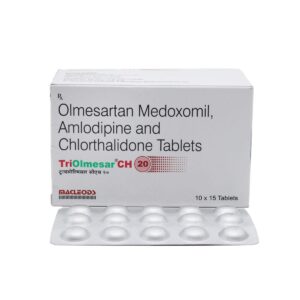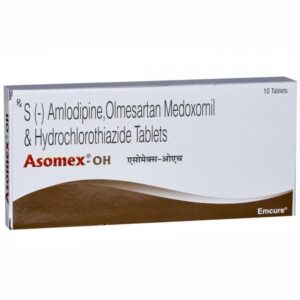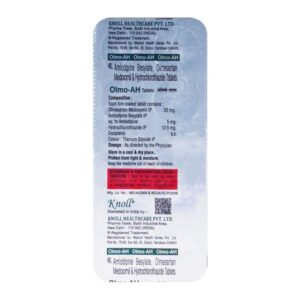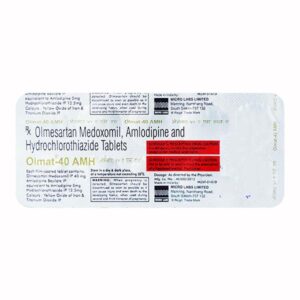HYDROCHLOROTHIAZIDE + AMLODIPINE + OLMESARTAN
Hydrochlorothiazide: Hydrochlorothiazide is a prescription medication primarily used to treat high blood pressure (hypertension) and fluid retention (edema) caused by various conditions such as heart failure, kidney disorders, and liver cirrhosis. It belongs to a class of medications called diuretics or “water pills.”
The mechanism of action of hydrochlorothiazide involves increasing the amount of water and salt expelled from the body through urine. This helps to reduce fluid buildup and lower blood pressure. It works by inhibiting the reabsorption of sodium and chloride ions in the distal convoluted tubules of the kidneys, thereby increasing water excretion.
The typical initial dose of hydrochlorothiazide for hypertension is 12.5 to 25 milligrams orally once daily. The dose may be adjusted by a healthcare professional based on the individual’s response and specific medical condition. For edema, the usual dose is 25 to 100 milligrams orally once daily or every other day.
Common side effects of hydrochlorothiazide may include increased urination, dizziness, low blood pressure, headache, muscle cramps, nausea, vomiting, and electrolyte imbalances (such as low levels of potassium, sodium, and chloride). These side effects are usually mild and transient.
Serious side effects are rare; however, if experienced, they should be reported to a healthcare provider immediately. These may include signs of allergic reactions (such as rash, itching, swelling, severe dizziness, or breathing difficulties), severe dizziness or lightheadedness, fainting, irregular heartbeat, rapid weight loss, and signs of kidney problems (such as decreased urine production or blood in the urine).
It is important to note that hydrochlorothiazide may interact with other medications, including some nonsteroidal anti-inflammatory drugs (NSAIDs), lithium, digoxin, certain diabetes medications, and corticosteroids. Therefore, it is essential to inform the healthcare provider about all current medications and medical conditions before starting hydrochlorothiazide.
Hydrochlorothiazide should be used cautiously in individuals with certain medical conditions, such as kidney or liver disease, gout, diabetes, lupus, or an allergy to sulfonamide medications.
This is a brief overview of hydrochlorothiazide. It is important to follow the prescribed dosage and directions given by your healthcare provider and consult them for more detailed information specific to your situation.
Amlodipine: Amlodipine is a medication primarily used to treat high blood pressure (hypertension) and certain types of chest pain called angina. It belongs to a class of drugs called calcium channel blockers.
Mechanism of Action:
Amlodipine works by blocking the entry of calcium into the smooth muscle cells of blood vessels and the heart. This prevents the contraction of these muscles, leading to relaxation of the blood vessels and improved blood flow. By reducing the workload on the heart, it also helps to lower blood pressure and relieve angina symptoms.
Dose:
The typical starting dose of amlodipine for hypertension is 5 mg once daily, which can be increased to a maximum dose of 10 mg per day if needed. For angina, the starting dose is usually 5 mg to 10 mg per day. The dosage may vary depending on individual factors such as age, other medical conditions, and response to treatment.
Side Effects:
Common side effects of amlodipine include headache, dizziness, flushing, swelling in the ankles or feet, and fatigue. These side effects are generally mild and diminish with continued use. Less frequently, amlodipine may cause more serious side effects such as an irregular heartbeat, chest pain, and allergic reactions. If any of these symptoms occur, it is important to seek medical attention.
Amlodipine is generally considered a safe and effective medication for the management of hypertension and angina. However, it is important to take the drug as prescribed and inform your healthcare provider about any other medications or medical conditions you have to ensure its safe and appropriate use.
Olmesartan: Olmesartan is a prescription drug belonging to a class of medications called angiotensin II receptor blockers (ARBs). It is primarily used to treat high blood pressure (hypertension) in adults and children over the age of 6.
The drug works by blocking the action of angiotensin II, a hormone that causes blood vessels to narrow. By inhibiting the binding of angiotensin II to its receptors, olmesartan helps to relax and widen the blood vessels, thus reducing blood pressure.
The recommended starting dose of olmesartan for most adults is 20 mg once daily. However, the dosage may be adjusted by a healthcare provider based on individual response. For children aged 6 to 16, the initial dose is determined based on body weight, with a maximum dose of 20 mg per day.
Like any medication, olmesartan has potential side effects, although not everyone experiences them. Common side effects may include dizziness, headache, fatigue, abdominal pain, diarrhea, chest pain, and back pain. In rare cases, it may cause more serious side effects such as allergic reactions, kidney problems, or high levels of potassium in the blood.
Before using olmesartan, it’s important to inform your healthcare provider about any medical conditions you have, especially kidney or liver disease, as well as medications you are currently taking, including over-the-counter drugs and herbal supplements, as they may interact with olmesartan.
As always, it is essential to follow the dosage instructions provided by your healthcare provider and to consult with them if you have any questions or concerns.





